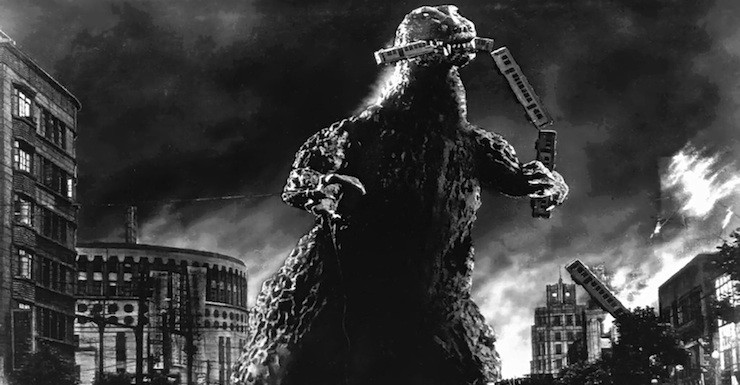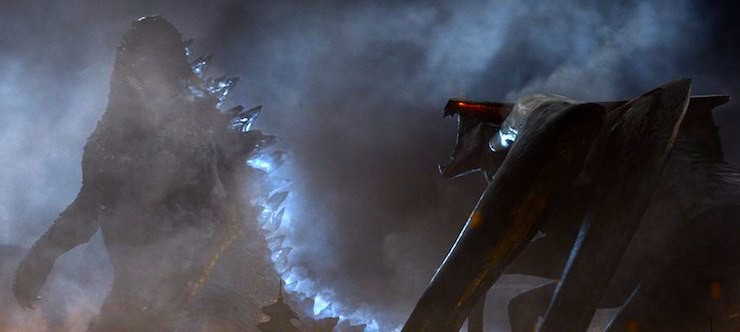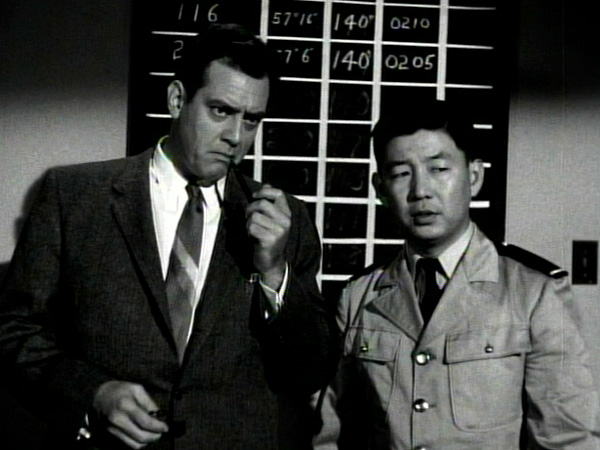It’s that time of the year again. There’s a slight chill to the late summer evenings. Leaves are starting to bring out their fall colors. Each day is just a bit shorter than the last. We can all feel what these changes signify. No, not going back to school, but that it’s the season for monster movies! Between now and Halloween I’ll be highlighting ten of the best toothy, sharp-clawed, and mutated aberrations to shred the silver screen. Some are old classics, others are newcomers, but all are awesome.
“If we don’t defend ourselves from Godzilla now, what will become of us?” Let’s talk about Gojira.
Since the monster’s debut in 1954, everyone’s favorite radioactive dinosaur has starred in twenty nine movies. (I don’t care what the title was, the 1998 American adaptation doesn’t count.) That’s a greater number of films than in the James Bond franchise, and not even consider the television shows, games, comics, and all the other associated memorabilia we’ve created to place at the shrine of Gojira. We love this scaly force of destruction.
The difficulty in trying to distill something from the legacy of Gojira, though, is that the monster has never been a singular entity. At various times in the past half century the monster has been a mindless destroyer, an ecological hero, the angered spirits of the dead, and an ancient predator that wakes up to “restore balance” to a new age of monsters, just to name a few. Every Gojira has something different to say.
Of course, Gojira hatched as an anti-nuclear metaphor. The original Gojira was a walking manifestation of the atomic bombs the United States military dropped on the towns of Hiroshima and Nagasaki just nine years before. Even though the origin of the original film owed a little of its inspiration to the cinematic success of King Kong and The Beast From 20,000 Fathoms, Ishirô Honda’s movie was something deeper and more meaningful than these adventure yarns. Gojira caused the same devastation as the horrific nuclear warfare the United States unleashed, and the social fallout from those events is an undercurrent throughout the entire film. Gojira was a way to cope with real life atomic terrors and as an embodiment of what humanity might yet awaken in the new nuclear age.
Not that I understood any of that when I was a kid. The sanitized and Americanized version—Godzilla: King of the Monsters—was the only version I ever saw. Editors excised the heart of the film and put journalist Steve Martin (Raymond Burr) in its place, turning the monster into a yet another entry in the genre of something ancient waking up to stomp civilization into the ground. And as a dinosaur-crazed kid, I loved it. Godzilla seemed to be an enormous, firebreathing combination of dinosaurs like Allosaurus and Stegosaurus, and seeing the monster roar over the burning Tokyo skyline stimulated the same parts of my brain as visits to Jurassic skeletons in the American Museum of Natural History.
From basic cable marathons to bargain bin VHS cassettes and bootlegs of hard-to-find films like Godzilla vs Biollante, I followed Gojira’s transformation from rampaging monster to prehistoric goofball to anti-hero. Every incarnation was a little bit different, not only in appearance but in tone. And that flexibility is why Gojira is still with us.
Gojira, as the films themselves have recognized, is a force of nature. A manifestation of something that’s so big it’s almost an abstraction. In the beginning the monster was a walking A-bomb, but over time Gojira has embodied other notions ranging from respect for the dead to simply making us feel small, perhaps reminding a more ancient part of our brains of a time when real saurians towered over our furry little Mesozoic ancestors. As our worries and fears for the future change, so will Gojira.
Brian Switek is the author of My Beloved Brontosaurus (out in paperback from Scientific American/Farrar, Straus and Giroux) and Written in Stone. He also writes the National Geographic blog Laelaps.













Okay, about the name… The official English-language spelling of the character’s name is Godzilla. The spelling comes from the romanization scheme that was common in the 1950s, in which the syllables making up the name were transliterated as go-zi-la or go-dzi-la, with the second L most likely added because the name was partly derived from “gorilla” (since it was chosen before the monster was designed). In Toho movies where the character’s name appears in English signage or text, it’s usually spelled Godzilla, and English-speaking characters in the original Japanese-language versions pronounce it “God-zill-a.” The Gojira spelling is a more modern romanization of the same syllables, but that doesn’t make it more correct; it’s just as inaccurate an interpretation of the sound (which is about halfway between the two spellings). And if anything, it’s anachronistic for a name that was coined in the ’50s. Gojira is used as the spelling of the title of the original film in English releases, but that’s really just to differentiate it from the English version, Godzilla: King of the Monsters. The character’s name is properly rendered in English as Godzilla. Calling him Gojira is an overcorrection.
While it’s true that the original film was a reaction to the bombings of Hiroshima and Nagasaki (and the dozens of other Japanese cities that were destroyed by conventional firebombings before them), it was most specifically an allegorical protest of the American H-bomb tests in the Marshall Islands in early 1954, tests that led to the irradiation of the crew of a nearby Japanese fishing boat (resulting in one fatality) and to the contamination of Japan’s soil and water with radioactive fallout. Even nine years after the war, American atomic weapons were still killing Japanese people, but Japan’s occupied status meant that they couldn’t openly protest, so they had to do it through allegory.
I thought gojira comes from kujira 鯨 (whale), not gorilla.
@2/birgit: It was coined as a hybrid of kujira (whale) and gorira (gorilla).